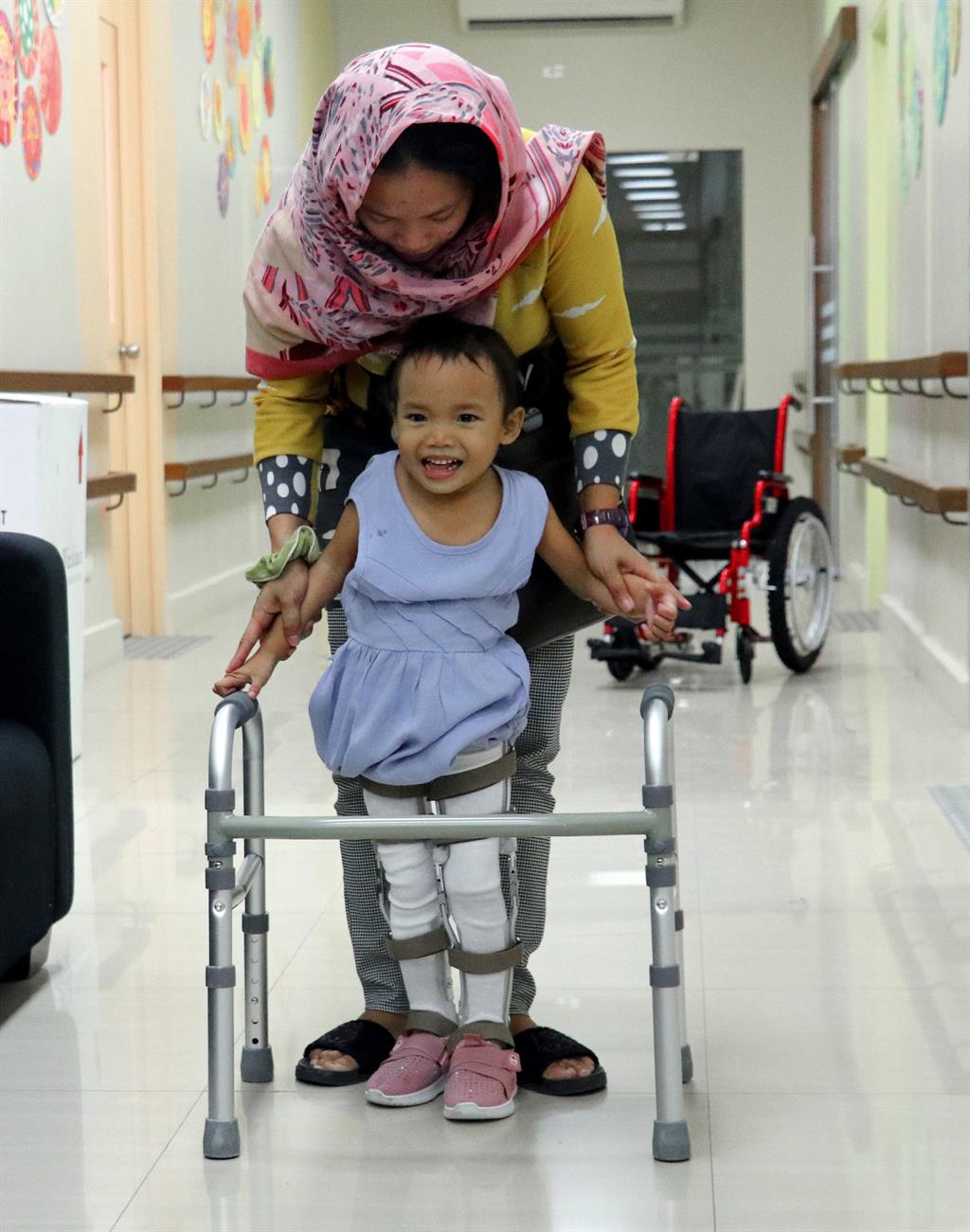Three-year-old Junaisa is the first polio case in the Philippines after almost two decades. Her parents Haimer and Salma shared their story when we visited them in Lanao del Sur last October 2019. We revisited them at the Philippine General Hospital (PGH) in Manila where Junaisa received rehabilitation services. This is the continuation of their story.
Along the corridor of the PGH Access, the hospital’s center for children with disabilities, Junaisa was practicing how to walk with her new leg braces. Smiling, she carefully took one step at a time while holding on to a walker. Her mother Salma followed closely, helping her balance after each step.
Salma helping Junaisa walk with her newly-fitted leg braces. Photo: WHO/J. Orbina
Salma was happy with Junaisa’s improvement, “Now she can somehow walk, unlike before, when she kept losing balance. If you assist her, she can now keep herself upright.”
When we visited their family in Lanao del Sur last October 2019, Junaisa stayed in bed most of the time. The girl needed her mother’s help in sitting down. Haimer shared that on days when Junaisa was scheduled for rehabilitation sessions at the Amai Pakpak Medical Center in Marawi City, he took turns with Salma in carrying Junaisa during their one-hour commute.
Upon hearing Junaisa’s story, partners reached out to offer help. The local chapter of Rotary International, in coordination with the Ministry of Health of the Bangsamoro Autonomous Region in Muslim Mindanao, contacted Junaisa’s family. Rotary International then connected with Physicians for Peace Philippines and the United Nations Children’s Fund (UNICEF) to arrange for the family’s travel to Manila for rehabilitation services at the PGH Access. The center is also supported by both organizations.
Junaisa’s progress had been more evident after two weeks at the center. “Now, she’s stronger. She can roll and crawl. If she wants to sit down, she can now do it by herself,” Salma said.
Polio is a disease that disables children permanently, usually in the legs. Rehabilitation through therapy and assistive devices like braces help polio survivors improve their mobility. These devices also prevent deformities, which typically occur when paralyzed limbs become fixed in one position.
Early intervention helps polio survivors like Junaisa cope with disability and gain their best possible physical function.
Rehabilitation has helped Junaisa to be able to sit on her own. Photo: WHO/J. Orbina
These interventions, however, can take a financial toll on families taking care of children with polio. Assistive devices have to be refitted or changed as the child grows.
Aside from leg braces, PGH Access also provided Junaisa with a customized walker and a wheelchair. All these were provided for free as Junaisa is the first beneficiary of the Philippine Health Insurance’s (Philhealth) mobility package for children with disabilities. She is also entitled to free assistive devices until she is 18 years old.
For Salma, seeing Junaisa walk is a step towards her dream. She wanted her little girl to be with other kids and finish her education, “Maybe the miracle is about to come – that she can walk on her own, even if with a limp. When she can walk, we can already enrol her in school.”
Salma and Haimer playing with their daughter Junaisa. Photo: WHO/J. Orbina
“I’m very thankful to everyone who helped us, that we were able to come here at the center,” Salma said.
While Salma appreciates all organizations that helped them, she also added that other parents can avoid the challenges that her family is facing in coping with a child with polio.
“I hope all mothers will have their children vaccinated so that this will not happen to their child. From where I come from, some mothers don’t bring their children for vaccination. They say, ‘that’s not true, my child will not get sick.’ Now, polio has become real for me.”
To date, fifteen other cases of polio have been confirmed in the Philippines. The Philippine Department of Health (DOH), with support from partners such as WHO and UNICEF, continues with additional rounds of the Sabayang Patak Kontra Polio, where children under five years old in Metro Manila and Mindanao are given polio drops. In areas not affected by the outbreak, DOH continues to strengthen routine immunization, which includes three doses of polio drops and one dose of the polio shot.
Salma emphasized an essential reminder for parents: “Children should really be immunized. Vaccines are needed so our children will not get sick.”
